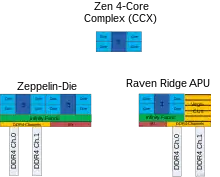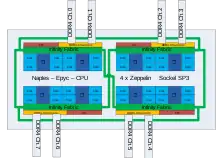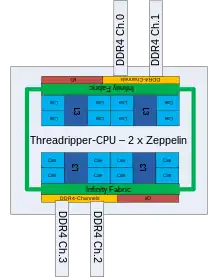Zen (microarchitecture)
Zen is the codename for a family of computer processor microarchitectures from AMD, first launched in February 2017 with the first generation of its Ryzen CPUs. It is used in Ryzen (desktop and mobile), Ryzen Threadripper (workstation/high end desktop), and Epyc (server).
Comparison
| Microarchitecture | Zen[1] | Zen 2[2] | Zen 3[3] | Zen 4[4] | |||||
|---|---|---|---|---|---|---|---|---|---|
| Microarchitecture variants | Zen | Zen+[5] | Zen 3 | Zen 3+ | |||||
| Fabrication process (nm) | 14 nm | 12 nm | 7 nm | 6 nm | 5 nm | ||||
| Cache[6] | µop | 2K | 4K | 6.75K | |||||
| L1 | Data | Size | 32 KB | ||||||
| Ways | 4 | 8 | |||||||
| Latency | ? | ? | ? | 4-8 | ? | ||||
| Instruction | Size | 64 KB | 32 KB | ||||||
| Ways | 8 | ||||||||
| Latency | 4-8 | ? | |||||||
| TLB | 512-entry | 1024-entry | |||||||
| L2 | Size | 512 KB/core | 1024 KB/core | ||||||
| Ways | 8 | ||||||||
| Latency | 17 | 12 | 14 | ||||||
| TLB | 1536-entry | 2048-entry | 3072-entry | ||||||
| L3 | Size | 2048 KB/core | 4096 KB/core | ||||||
| Ways | 16[7] | ||||||||
| Latency | 35 | 40 | 46 | 50 | |||||
| Max CPU core | 32 | 64 | 8 | 96[8] | |||||
| Simultaneous multithreading (SMT) | |||||||||
| OoO window (ROB) | 192 | 224 | 256 | 320 | |||||
| Pipeline | stage | 19 | |||||||
| Decode (ways) | 4 | 6[9] | |||||||
| Scheduler | Entries | ? | |||||||
| Dispatch | 6 | ||||||||
| Register file | Integer | 84 | 92 | 96 | 224[10] | ||||
| Floating-point | 96 | 160[10] | 192[10] | ||||||
| Queue | Instruction | 72 | |||||||
| Allocation | 44 | ||||||||
| AGUs | 2 | 3 | |||||||
History



First generation
The first generation Zen was launched with the Ryzen 1000 series of CPUs (codenamed Summit Ridge) in February 2017.[11] The first Zen-based preview system was demonstrated at E3 2016, and first substantially detailed at an event hosted a block away from the Intel Developer Forum 2016. The first Zen-based CPUs reached the market in early March 2017, and Zen-derived Epyc server processors (codenamed "Naples") launched in June 2017[12] and Zen-based APUs (codenamed "Raven Ridge") arrived in November 2017.[13] This first iteration of Zen utilized GlobalFoundries' 14 nm manufacturing process.[14] Modified Zen-based processors for the Chinese market were built.
First generation refresh
Zen+ was first released in April 2018,[15] powering the second generation of Ryzen processors, known as Ryzen 2000 (codenamed "Pinnacle Ridge") for mainstream desktop systems, and Threadripper 2000 (codenamed "Colfax") for high-end desktop setups. Zen+ used GlobalFoundries' 12 nm process, an enhanced version of their 14 nm node.[16][17]
Second generation
The Ryzen 3000 series CPUs were released on July 7, 2019,[18][19] while the Zen 2-based Epyc server CPUs (codename "Rome") were released on August 7, 2019.[20] Zen 2 Matisse products were the first consumer CPUs to use TSMC's 7 nm process node.[21] Zen 2 introduced the chiplet based architecture, where desktop, workstation, and server CPUs are all produced as multi-chip modules (MCMs); these Zen 2 products utilise the same core chiplets but are attached to different uncore silicon (different IO dies) in a hub and spoke topology. This approach differs from Zen 1 products, where the same die (Zeppelin) is used in a simple monolithic package for Summit Ridge products (Ryzen 1000 series) or used as interconnected building blocks in an MCM (up to four Zeppelin dies) for first generation Epyc and Threadripper products.[22] For earlier Zen 2 products the IO and uncore functions are performed within this separate IO die,[23] which contains the memory controllers, the fabric to enable core to core communication, and the bulk of uncore functions. The IO die used by Matisse processors is a small chip produced on GF 12 nm,[24] whereas the server IO die utilized for Threadripper and Epyc is far larger.[24] The server IO die is able to serve as a hub to connect up to eight 8-core chiplets, while the IO die for Matisse is able to connect up to two 8-core chiplets. These chiplets are linked by AMD's own second generation Infinity Fabric,[24] allowing a low-latency interconnect between the cores and to IO. The processing cores in the chiplets are organized in CCXs (Core Complexes) of four cores, linked together to form a single eight core CCD (Core Chiplet Die).[25]
Zen 2 also powers a line of mobile and desktop APUs marketed as Ryzen 4000, as well as fourth generation Xbox consoles and the PlayStation 5. The Zen 2 core microarchitecture is also used in the upcoming Mendocino APU, a 6nm system on a chip aimed at mainstream mobile and other energy efficient low power computing products.[26]
Third generation
Zen 3 was released on November 5, 2020,[27] using a more matured 7 nm manufacturing process, powering Ryzen 5000 series CPUs and APUs[27] (codename "Vermeer" (CPU) and "Cézanne" (APU)) and Epyc processors (codename "Milan"). Zen 3's main performance gain over Zen 2 is the introduction of a unified CCX, which means that each core chiplet is now composed of eight cores with access to 32MB of cache, instead of two sets of four cores with access to 16MB of cache each.[28]
On April 1, 2022, AMD released the new Ryzen 6000 series for the laptop, using an improved Zen 3+ architecture, bringing RDNA 2 graphics integrated in a APU to the PC for the first time.[29]
Zen 3D was officially previewed on May 31, 2021,[30] and released on April 20, 2022. Zen 3D differs from Zen 3 in that it includes V-Cache, which is 3D-stacked L3 cache. This added cache brings an approximately 15% performance increase in gaming applications on average.[31]
Zen 3D for server, codenamed Milan-X was announced in AMD Accelerated Data Center Premiere Keynote on November 8, 2021. It should bring a 50% increase in select datacenter applications over Zen 3's Milan CPUs while maintaining socket compatibility with them.[32] Milan-X was released on March 21, 2022.[33]
Fourth generation
Epyc server CPUs with Zen 4, codenamed Genoa, were officially unveiled at AMD's Accelerated Data Center Premiere Keynote on November 8, 2021,[34] and released a year later in November 2022.[35] They have up to 96 Zen 4 cores and support both PCIe 5.0 and DDR5.
Furthermore, Zen 4 Cloud (a variant of Zen 4), abbreviated to Zen 4c and codenamed Bergamo, was also announced. Zen 4c is designed to have significantly greater density than standard Zen 4 while delivering greater power efficiency. This is achieved by redesigning Zen 4's cache (presumably removing a certain amount of L2 and L3 cache) to maximise density and compute throughput. Bergamo will have up to 128 Zen 4c cores and will be socket-compatible with Genoa.
Both Zen 4 and Zen 4 Cloud will be manufactured on a non-specified variety of TSMC 5 nm and are slated to launch in 2022.[32]
In addition to the Epyc 7004 server processors (Genoa and Bergamo), in May 2022 AMD's roadmap showed that Zen 4 will power Ryzen 7000 mainstream desktop processors (codenamed "Raphael"), high-end mobile processors (codenamed "Dragon Range"), thin and light mobile processors (codenamed "Phoenix").[36][37][38]
Fifth generation
Zen 5 was shown on AMD's Zen roadmap in May 2022.[36] It is believed to use TSMC's 3 nm process.[39] It will power Ryzen 8000 mainstream desktop processors (codenamed "Granite Ridge"), high-end mobile processors (codenamed "Strix Point"), and Epyc 7005 server processors (codenamed "Turin").
See also
References
- "Zen - Microarchitectures - AMD". WikiChip. Retrieved September 16, 2021.
- "Zen 2 - Microarchitectures - AMD". WikiChip. Retrieved September 16, 2021.
- "Zen 3 - Microarchitectures - AMD". WikiChip. Retrieved September 16, 2021.
- "Zen 4 - Microarchitectures - AMD". WikiChip. Retrieved October 10, 2022.
- "Zen+ - Microarchitectures - AMD". WikiChip. Retrieved October 10, 2022.
- Here, K, M, G, or T refer to the binary prefixes based on powers of 1024.
- "AMD Ryzen 7 5800H Mobile processor - 100-000000295". CPU-World. Retrieved September 17, 2021.
- Bonshor, Gavin (June 9, 2022). "AMD Announces Genoa-X: 4th Gen EPYC with Up to 96 Zen 4 Cores and 1GB L3 V-Cache". AnandTech. Retrieved October 10, 2022.
- Cutress, Ian (November 5, 2020). "AMD Zen 3 Ryzen Deep Dive Review: 5950X, 5900X, 5800X and 5600X Tested". AnandTech. Retrieved November 15, 2021.
- "AMD's Zen 4 Part 1: Frontend and Execution Engine".
- Anthony, Sebastian (August 18, 2016). "AMD says Zen CPU will outperform Intel Broadwell-E, delays release to 2017". Ars Technica. Retrieved August 18, 2016.
- Cutress, Ian (June 20, 2017). "AMD's Future in Servers: New 7000-Series CPUs Launched and EPYC Analysis". AnandTech. Retrieved August 8, 2017.
- "HP ENVY x360 Convertible Laptop - 15z touch". HP Official Store.
- Lilly, Paul (July 23, 2016). "AMD Shipping Zen In Limited Quantity Q4, Volume Rollout Ramps Q1 2017". HotHardware. Archived from the original on April 21, 2019. Retrieved October 21, 2020.
- Bright, Peter (January 8, 2018). "AMD's 2018 roadmap: Desktop APUs in February, second-generation Ryzen in April". Ars Technica. Retrieved January 9, 2018.
- Cutress, Ian. "The AMD 2nd Gen Ryzen Deep Dive: The 2700X, 2700, 2600X, and 2600 Tested". Anandtech. Retrieved October 21, 2020.
- Hruska, Joel (September 22, 2017). "AMD Will Use 'New' GlobalFoundries 12nm Node for Future CPUs, GPUs". ExtremeTech. Retrieved October 21, 2020.
- Leather, Antony. "AMD Ryzen 9 3900X and Ryzen 7 3700X Review: Old Ryzen Owners Look Away Now". Forbes. Retrieved September 19, 2019.
- "AMD Ryzen 3000 CPUs launching July 7 with up to 12 cores". PCGamesN. Retrieved May 28, 2019.
- "2nd Gen AMD EPYC™ Processors Set New Standard for the Modern Datacenter with Record-Breaking Performance and Significant TCO Savings". AMD. August 7, 2019. Retrieved August 8, 2019.
- January 2020, Bill Thomas 15 (January 15, 2020). "AMD Zen 2 specs, price and release date: all about AMD's newest processor tech". TechRadar. Retrieved October 21, 2020.
- "Naples Zeppelin vs. Rome Chiplet (subsection)".
- btarunr (June 12, 2019). "AMD Ryzen 3000 'Matisse' I/O Controller Die 12nm, Not 14nm". TechPowerUp. Retrieved October 21, 2020.
- Cutress, Ian (June 10, 2019). "AMD Zen 2 Microarchitecture Analysis: Ryzen 3000 and EPYC Rome". AnandTech. Retrieved October 21, 2020.
- September 2019, Scharon Harding 14 (September 14, 2019). "What Is an AMD CCX? A Basic Definition". Tom's Hardware. Retrieved October 21, 2020.
- Ryan Smith (May 23, 2022). "AMD Announces Mendocino APU: 6nm Mainstream Mobile Zen 2 Laptop Chip Coming In Q4".
- Ridley, Jacob (October 8, 2020). "AMD Ryzen 5000 – Zen 3 CPU release date, specs, pricing, and performance". PC Gamer. Retrieved October 20, 2020.
- "AMD's Zen 3 Drops November 5 With Major IPC Enhancements -". ExtremeTech. Retrieved October 21, 2020.
- "AMD Unveils New Ryzen Mobile Processors Uniting "Zen 3+" core with AMD RDNA 2 Graphics in Powerhouse Design". AMD (Press release). Santa Clara, CA. January 4, 2022. Retrieved May 27, 2022.
- AMD at Computex 2021, retrieved November 15, 2021
- "Ryzen 7 5800X3D vs. Ryzen 7 5800X: Zen 3 Gaming Shootout". TechSpot. Retrieved July 11, 2022.
- AMD Accelerated Data Center Premiere Keynote, retrieved November 15, 2021
- WhyCry. "AMD EPYC 7003 'Milan-X' launches March 21st, specs and pricing leaked". VideoCardz.com. Retrieved July 11, 2022.
- Hertz, Jake (November 15, 2021). "AMD Teases More Data Center Processors at 2021 Accelerated Data Center Premiere". All About Circuits. Retrieved June 6, 2023.
- "AMD Launches 4th Gen EPYC "Genoa" Zen 4 Server Processors: 100% Performance Uplift for 50% More Cores". TechPowerUp. November 11, 2022. Retrieved June 6, 2023.
- "AMD confirms Zen4 & Ryzen 7000 series lineup: Raphael in 2022, Dragon Range and Phoenix in 2023". VideoCardz.com. May 3, 2022.
- Zhiye Liu (May 3, 2022). "AMD Confirms Zen 4 Dragon Range, Phoenix APUs for 2023". Tom's Hardware.
- Anthony Garreffa (May 3, 2022). "AMD confirms Ryzen 7000 series CPUs this year: Zen 4 + DDR5 + PCIe 5.0". Tweaktown.
- Hassan Mujtaba (May 1, 2022). "AMD Zen 5 CPUs Might Get Delayed To 2024-2025 Due To TSMC's Priority Allocation of 3nm Node To Intel & Apple Zen 5". Wccftech.